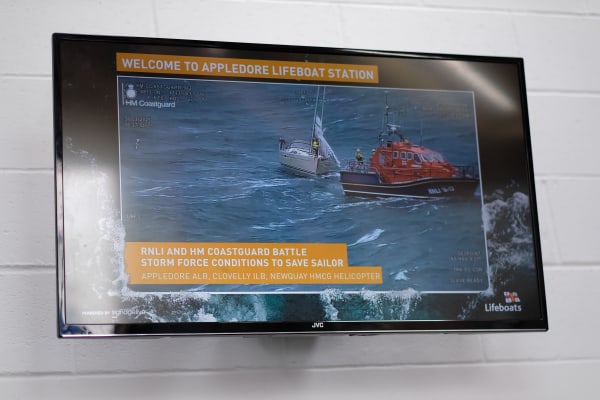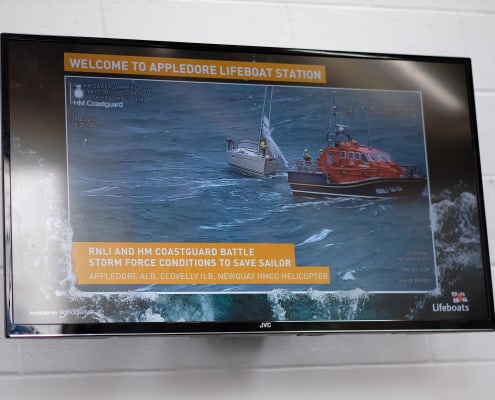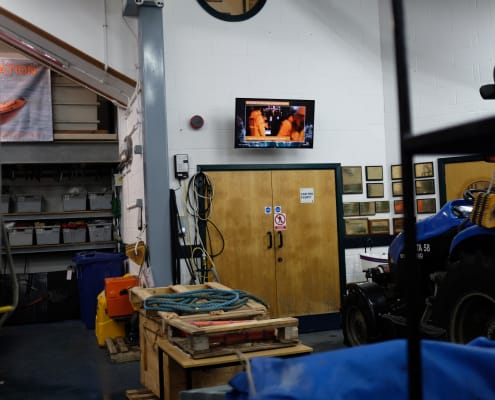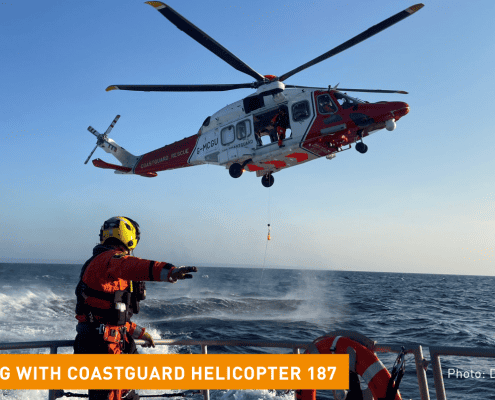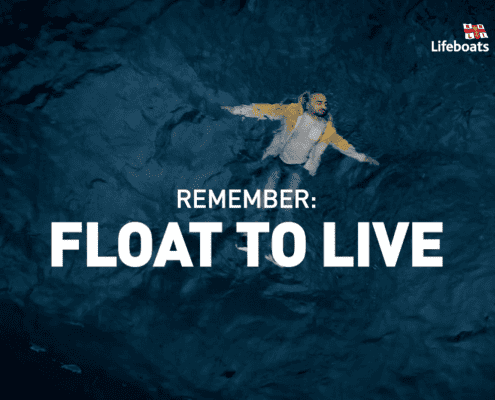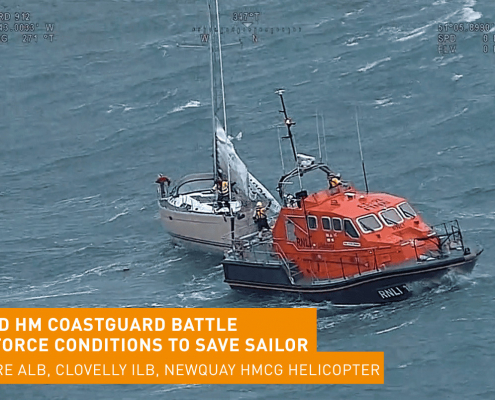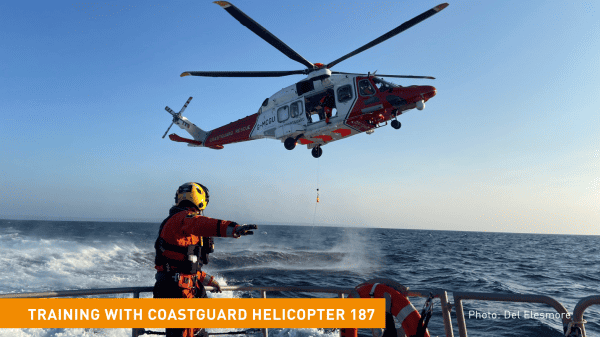Appledore Lifeboat Station shores up community support with Signagelive digital signage [+VIDEO]
A base for the Royal National Lifeboat Institution (RNLI) search and rescue operations in Devon, Appledore Lifeboat Station is riding the crest of a wave, after the successful launch of its first ever digital signage system.
The installation of a 40-inch screen, powered by Signagelive, has enabled the team to take the helm and raise more awareness – and funds – for the charity, and the work that it does.
Since launching the system in April, there has been a significant increase in visitor engagement, with more opportunity for crew members to immerse the public in inspiring news about what the Lifeboat Station does for the local community.
The digital signage solution
Installed in a prime viewing location above the D-class boat at the station, the one-screen solution is made up of a single JVC display, an Amazon Fire TV Stick, which serves as a media player, and a free content management system (CMS) Licence, gifted by Signagelive.
The solution has, according to Bob Meller, Appledore RNLI Lifeboat Operations Manager, been game-changing: “We can now talk to visitors in near real-time and build on the interest and publicity generated by some of the most recent rescues that we’ve made. We can use our own footage to flesh out those rescue stories and bring them to life. It’s quickly become an important way for us to forge deeper connections with the local community, and the tourists who visit us every year.
The scope of what we can do – the potential – is beyond anything that we imagined, and we are continually developing the content.”
Initially, the digital signage was only going to be used to digitise and display historical photographs of generations of past crew members and pay homage to the history of the Lifeboat Station.
Since the first boat was stationed in the village in 1825, the RNLI has developed a long tradition of saving lives at sea, relying on the selflessness and bravery of local volunteers.
“We wanted to be able to highlight our deep roots with the community – our charity’s longstanding contribution- all to help inspire local support”, explains Meller.
“However, we quickly realised that, with this digital signage system, we could do so much more to connect with the public. We could let them experience what we see and do.”
Fly-on-the-wall raw footage
One of the most powerful ways that the crew has been able to do this is to share RNLI-approved head cam and onboard boat camera footage. Stories of local rescues that have hit the news, and/or gone viral can be shared, fly-on-the-wall documentary style, through the eyes of the volunteers themselves. This kind of first-person storytelling has enthralled local visitors, resulting in throngs of people forming around the screen to immerse themselves in rescue stories that they have previously seen in local newspapers, TV or social media.
The footage and/or photos used so far include those of a sailor being pulled from his damaged yacht during Storm Mathis, and a rescue of two men on a fishing boat, which was dragged out into the South Tail on the notorious Bideford Bar.
Most recently, the Appledore Lifeboat Station team has captured the imagination of visitors with footage of the rescue of a giant inflatable duck, nicknamed Quackers. Receiving blanket coverage in the nationals, this featured story details how three adult males became stranded on the inflatable, which drifted 200 metres offshore. While the men were fortunately rescued by a local paddleboarder, who happened to be nearby, the task of retrieving Quackers was left to the Appledore volunteer crew.
Water safety advice
These kinds of stories have proven to be valuable talking-points, giving the team the opportunity to illustrate safety pointers and help make RNLI advice more relatable.
The team has, for example, leveraged the new-found celebrity status of Quackers, keeping the oversized duck in the Boat House as a visitor draw, and then using it as an on-screen character to warn against taking inflatables into the sea.
Inclusive team environment
The installation of the signage hasn’t just signalled a sea change in how the crew are engaging with the local community, but also their own team. For the first time, it’s enabled the shore crew, shop staff and fundraisers to see what happens during the rescues.
“The shore crew are fundamental to the success of our rescues”, says Meller, “helping to launch and recover our lifeboats and maintain them. However, they don’t generally get to see the lifeboats in action, so this is a way for us to ensure they feel more connected to the rest of the team, and a part of the rescues we make.”
Training footage
With the Signagelive-powered digital signage system, the crew has also been able to share video footage of their training, including sessions with the coastguard helicopter. Proving popular, the footage has enabled visitors to experience, up close and personal, a snapshot of just what it takes to train and develop the skills necessary to save lives at sea.
“It’s a way”, insists Meller, “of allowing the public, in as far as possible, to walk in our shoes and re-live our experiences via the screen. The on-screen viewing experience gives them a far-greater appreciation of what our volunteers do, helping to inspire many to contribute to our various fundraising efforts.”
As part of a registered charity, which is entirely dependent on the donations of the public, the Appledore Lifeboat Station regularly hosts fundraising events.
Fundraising promotional calendar
With the Signagelive CMS, the crew has been able to proactively and impactfully advertise these events, while visitors are still at the Lifeboat Station and entirely engaged. Using the CMS Advanced Scheduling functionality, the fundraising team have created a year-long calendar, promoting events, which include everything from tea parties, and ABBA tribute nights to the annual station-to-station walk, and Christmas carol service with the Appledore Silver Band. They keep the on-screen promotions relevant and timely, having pre-set them to disappear from the screen the moment the event they advertise has passed.
Ideal for the busy Lifeboat Station environment, the creation and scheduling of content also doesn’t cut into the crew members’ schedules, as the cloud-based system can be used remotely from anywhere and at any time. For further time-saving support, the crew can also make last-minute updates, or corrections remotely, even after the content has been published, thanks to the platform’s live editing feature.
Cohesive visitor communications strategy
For the first time, with Signagelive digital signage, the Appledore team has also been able to roll out a more cohesive visitor communications strategy, and proactively drive traffic to other RNLI visitor touch points. This includes the off-site RNLI Gift Shop that’s located in a nearby outlet shopping centre.
Drawing on the platform’s content tools, the team has built on the visual impact of this advertising and other content, overlaying, for instance, the on-screen image with a touch of ocean spray to keep the maritime theme front of mind.
Of the Signagelive-powered digital signage, Tim Baker, Signagelive Marketing Manager said: “It’s truly been a privilege to be a part of this project. We often hear about how digital signage solutions can transform businesses, but what’s often overlooked is what it can do for not-for-profit organisations and charities. With the Appledore Lifeboat Station, we clearly see the potential for it to drive engagement and fundraising. Remotely accessible, and packed full of content tools for users of all abilities, cloud-based solutions offer out-of- the-box support and can work seamlessly with a whole host of screen and media player brands. With some CMS companies like ours now also becoming ISO27001 certified, we can also offer the highest data protection standards.”
Meller concludes: “We couldn’t have anticipated the difference digital signage would make. In the space of a couple of short months, we have been able to create more content and display it via a more engaging medium, as well as step up our fundraising efforts. It’s helped us strengthen our ties to the local community, as well as bring our team closer together.
Best of all, it’s been easy to use and low maintenance, enabling us to get on with our volunteer jobs.
We’ve only scratched the surface of what we can do and are already considering using the signage solution to run 360-degree walkabout videos of our all-weather lifeboat to enhance the visitor experience.”
For more information about the RNLI and how you can contribute, please visit
About RNLI
The RNLI charity saves lives at sea. Its volunteers provide a 24-hour search and rescue service around the United Kingdom and Republic of Ireland coasts. The RNLI operates 238 lifeboat stations in the UK and Ireland and more than 240 lifeguard units on beaches around the UK and Channel Islands. The RNLI is independent of Coast Guard and government and depends on voluntary donations and legacies to maintain its rescue service. Since the RNLI was founded in 1824, its lifeboat crews and lifeguards have saved over 142,700 lives.
Learn more about the RNLI
For more information please visit the RNLI website or Facebook, Twitter and YouTube. News releases, videos and photos are available on the News Centre.

